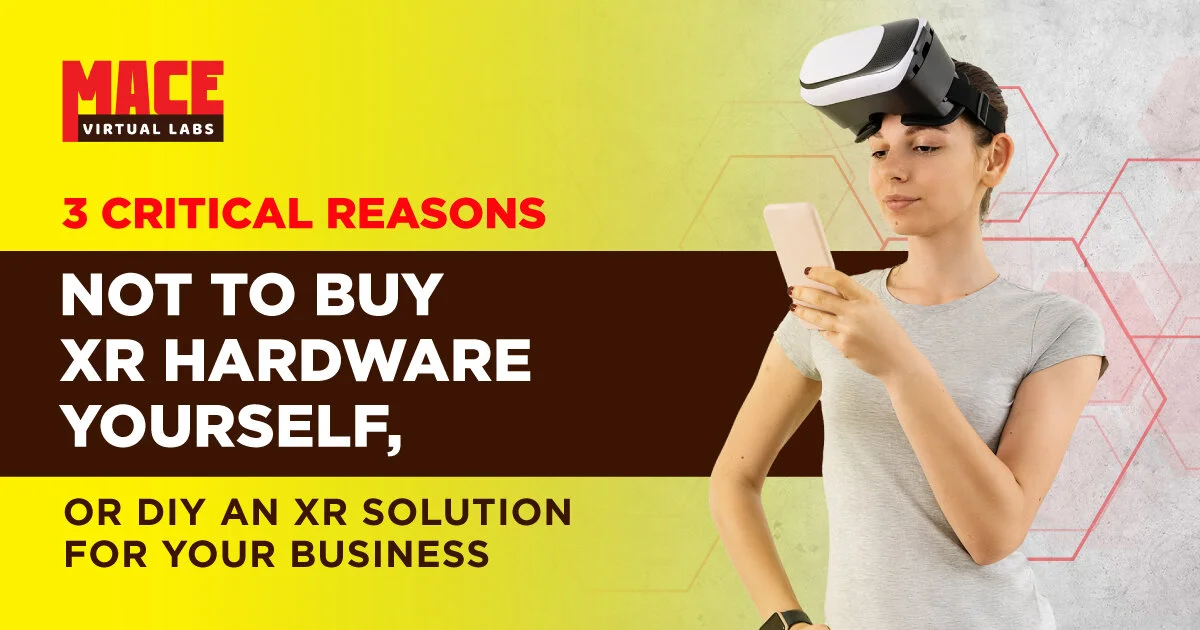3 Critical Reasons NOT to Buy XR Hardware Yourself, or DIY an XR Solution for Your Business
In almost any industry, you’ll find businesses that boast about the low prices they can offer by cutting out the middle-man. From prescription eyeglasses to mattresses, many companies in the 21st century have embraced direct-to-consumer models that ultimately cut their operating costs.
Instinctually, many of us are now looking for ways to similarly cut out costly intermediaries for our business. However, there are some industries that are, for lack of a better term, irreducibly complex. Virtual and augmented reality for education, enterprise and beyond are one such example. XR solutions have grown more prevalent in business, healthcare, education and military contexts, but the creation of these solutions simply cannot be done on your own, without professional expertise. While you might initially save money by purchasing AR or VR hardware and attempting to build a comprehensive solution yourself, you’ll ultimately need the support of an expert.
We’ll explore the benefits of working with expert support, and why your business, university or other institution should not endeavor to build a VR solution without that support.
1. Lack of XR Product Information
Some XR products, like gaming headsets, can be sold directly to consumers and set up with little more than a manual. But the XR hardware that you’ll need for a full-bodied program has steep learning curves for the uninitiated. In theory, it sounds great to incorporate AR instruction into your biology course, or VR training for your factory workers; but without expert guidance, you’ll be feeling around in the dark on the following factors:
Choosing the Best XR Product for Your Solution
Every line of headsets, gloves and other hardware has unique characteristics. Certain hardware and software is better suited to your desired XR program than others, and only an expert can advise you on the proper selection for your needs. Unless you have a background in VR, you’ll need the help of professionals to figure out how to select the right headsets, motion simulators, gloves, treadmills, and suits for your VR or AR solution. Without it, you risk choosing something that doesn’t ultimately cater to your needs, or falls short where another selection would’ve excelled.
Product Integration
VR hardware is a highly sophisticated and specialized branch of technology, and not every component of this technology will work together seamlessly. Unless you want to risk “saving money” on incompatible pieces of equipment, you’ll need someone who knows how different VR products can (or cannot) work together.
Discerning a Fair Price
VR is continuing to evolve, making it difficult to discern both the quality and price of potential products. On top of this, many top ten lists of best equipment found on Google searches are populated by affiliate products, making it difficult to find trustworthy guidance.
Again, professionals can help you navigate concerns of cost and benefit. What’s more, a company like MACE Virtual Labs will even allow you to rent your equipment, giving you a chance to test out hardware before pulling the trigger on a purchase.
2. No Plan for Fleet Management
Investing in VR equipment means more than just purchasing it. You must also maintain, update, and manage your XR fleet. Fleet management is the art of keeping your XR devices organized, charged, clean, up-to-date and managed as they’re distributed to users. Considering any enterprise-grade VR solution will involve dozens––if not hundreds––of pieces of equipment, you’ll need to account for the inventory management, sanitation, and software concerns of this hardware.
Inventory Management: XR equipment will inevitably need to be shipped, and professional fleet managers will help you get the equipment where it needs to be, safely, reliably, and on time. This ensures that your expensive XR devices don’t get lost, misplaced, or mishandled by untrained staff.
Sanitation: With most VR equipment coming into close contact with multiple users, you’ll want to protect your employees by ensuring proper sanitation after use. A turnkey XR provider will incorporate sanitation equipment into your solution, using cabinets that can disinfect equipment with UV light.
Software: VR solutions are more complex than average workplace technology, and they require careful and consistent calibration to function correctly. An essential element of fleet management is regularly updating the software needed for this equipment to run smoothly, without mishandling installation.
3. No Customer Support
What happens when your VR or AR equipment stops working for an unknown reason? If you choose a DIY approach to an XR solution, you’ll be left to figure out this problem on your own.
Unfortunately, there are many areas in which VR equipment can stall or cease to work properly, making it all the more important that you have access to support and training in these instances.
Complex XR Solutions Aren’t Ready for DIY
With a continually changing landscape, VR can revolutionize educational departments, training, and entertainment, but it’s complex to conceptualize, implement, and manage. At the enterprise level, you wouldn’t wing it when it comes to the safety and security of your company’s data; rather, you’d employ IT professionals. Similarly, when it comes to VR technology, you’ll want to rely on the pros.
MACE Virtual Labs has helped dozens of businesses, educational institutions and more build turnkey XR solutions from scratch. MACE will guide you through every step of the VR process, from developing the ideal solution to sourcing, implementing, and installing your equipment. They’ll even provide onsite training for your staff and ongoing remote support. While VR technology can be complex and esoteric, MACE has the expertise to make it work for your business.


